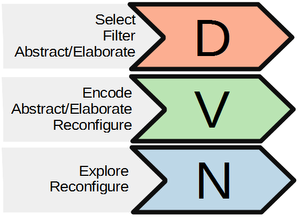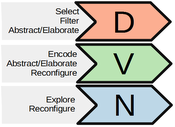Information
- Publication Type: Conference Paper
- Workgroup(s)/Project(s):
- Date: October 2015
- Series: Springer Lecture Notes in Computer Science (LNCS) series
- Publisher: The Eurographics Association
- Location: Aachen, Germany
- Lecturer: Johannes Sorger
- ISSN: 0302-9743
- Editor: David Bommes and Tobias Ritschel and Thomas Schultz
- Booktitle: 20th International Symposium on Vision, Modeling and Visualization (VMV 2015)
- Conference date: 7. October 2015 – 10. October 2015
Abstract
Research on visual data representations is traditionally classified into methods assuming an inherent mapping from data values to spatial coordinates (scientific visualization and real-time rendering) and methods for abstract data lacking explicit spatial references (information visualization). In practice, however, many applications need to analyze data comprising abstract and spatial information, thereby spanning both visualization domains. Traditional classification schemes do not support a formal description of these integrated systems. The contribution of this paper is a taxonomy that describes a holistic design space for integrating components of spatial and abstract visualizations. We structure a visualization into three components: Data, Visual, and Navigation. These components can be linked to build integrated visualizations. Our taxonomy provides an alternative view on the field of visualization in a time where the border between scientific and information visualization becomes blurred.Additional Files and Images
Weblinks
No further information available.BibTeX
@inproceedings{sorger-2015-taxintec,
title = "A Taxonomy of Integration Techniques for Spatial and
Non-Spatial Visualizations",
author = "Johannes Sorger and Thomas Ortner and Harald Piringer and
Gerd Hesina and Eduard Gr\"{o}ller",
year = "2015",
abstract = "Research on visual data representations is traditionally
classified into methods assuming an inherent mapping from
data values to spatial coordinates (scientific visualization
and real-time rendering) and methods for abstract data
lacking explicit spatial references (information
visualization). In practice, however, many applications need
to analyze data comprising abstract and spatial information,
thereby spanning both visualization domains. Traditional
classification schemes do not support a formal description
of these integrated systems. The contribution of this paper
is a taxonomy that describes a holistic design space for
integrating components of spatial and abstract
visualizations. We structure a visualization into three
components: Data, Visual, and Navigation. These components
can be linked to build integrated visualizations. Our
taxonomy provides an alternative view on the field of
visualization in a time where the border between scientific
and information visualization becomes blurred.",
month = oct,
series = "Springer Lecture Notes in Computer Science (LNCS) series",
publisher = "The Eurographics Association",
location = "Aachen, Germany",
issn = "0302-9743",
editor = "David Bommes and Tobias Ritschel and Thomas Schultz",
booktitle = "20th International Symposium on Vision, Modeling and
Visualization (VMV 2015)",
URL = "https://www.cg.tuwien.ac.at/research/publications/2015/sorger-2015-taxintec/",
}



